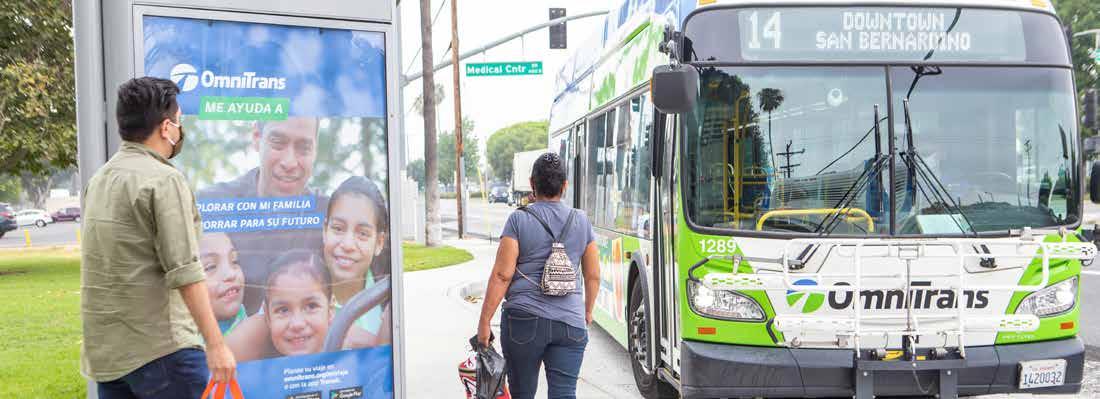
4 minute read
4.5 Best Practices Research
Best practices research was conducted in the earlier stage of the planning process. The research included reviewing transit research as well as studies from other similar-size transit agencies from around the region and across the country that have recommendations to successfully improve bus stop safety. A list of studies reviewed to find the latest best practices for bus stop safety are shown at the end of this chapter.
The primary goal of a transit agency is to provide passengers with transportation to their destination in a safe, convenient, efficient, and reliable manner.11 The physical safety of passengers is vital to the success of any transit system to not only retain existing ridership but also encourage new riders.11 Ultimately, it is important that bus stops are easily identifiable, safe, accessible, and a comfortable place to wait for the bus.12 This section starts with discussing personal safety at bus stops then traffic safety as it affects bus stop safety. 4.5.1 Safety at Bus Stops Transit agencies and local jurisdictions can play an important role in making conditions safe for people traveling to and from transit stops. Transit agencies help by ensuring their vehicles are operated safely near pedestrians and that their stops and stations provide safe pedestrian access.12 This section will cover the following topics as relates to pedestrians and bus stops:
Advertisement
» Number of safety concerns reported by passengers » Land Use and Personal Safety » Lighting for Personal Safety » Visibility for Personal Safety » Community Outreach » Bus Stop Facility Modifications for Personal Safety » Placemaking and Space Activation
A critical criterion for measuring the quality of public transportation is safety and security as research has shown how different types of settings generate large amounts of crime.16
Research has consistently demonstrated that crime, and fear of crime, can affect ridership.16 Many people have fears of riding public transit and waiting at transit stops, which can be a major obstacle for transit agencies to encourage transit travel, improve transit services, and implement transit-oriented development including more compact, mixed, walkable development around transit stations and routes.16 More precise and positive information about bus stop safety and riding a bus can help planners design safer and healthier communities and build more efficient and equitable transportation systems.15 To make passengers feel safer at bus stops and to reduce the number of safety concerns reported by passengers, it is ideal for bus stops to be in non-isolated, visible, well-lit locations. Increased diversity and density of uses near bus stops increases the number of people that see and effectively help monitor safety at bus stops.
It is recommended that placemaking and space activation measures be implemented to attract people to areas near bus stops. More people on the street will often be effective in reducing crime and improving safety.
The following types of policies are effective for reducing likelihood of crime:
» Encourage compact development that can be supported by public transit » Provide safe sidewalks and protected bike routes to bus stops » Provide high quality transit and stops for rest, reading, telephone, computer, homework, or similar while waiting for the bus » Provide high quality transit service: speed, stops, safety and security » Provide practical guidance about how people should respond if they see dangerous or inappropriate activity
land Use and Personal Safety
Buildings, as controlled by local land use categories, can significantly impact quality of the walking environment and improve the community experience.13
Buildings can offer a sense of safety, security, wayfinding, and protection as people walk around their neighborhood.13 Building uses, such as retail increase activity and can contribute to safety by adding “eyes on the street.”13 It is important to ensure that “eyes on the street” do not result in more racial profiling, but instead add to the sense of community and connection among the public. Generally, it is best to site a bus stop next to popular destinations that are safe, clean, and well-maintained with larger volumes of activity.20 This will increase the number of people that can ‘keep an eye out’ for one another without feeling isolated or at risk. Space activation can be an effective way to make people feel safer.
When bus stops are placed far from destinations, then adding art and activities can increase the appeal of waiting at a bus stop. Additional options might include a little free library, a chalkboard for drawing, or a play sculpture/play structure. At bus stops that do not have benches, it is recommended that a horizontal bar be placed near the bus stop so people, especially senior citizens, can rest by leaning against the bar when waiting at bus stops. It should be noted that bus stop spacing and placement is based on the Omnitrans Transit Design Guidelines (2013) including 1/2 mile walking distance to provide access to the maximum number of people. The final bus stop location is also affected by existing constraints like available space to construct the bus stop, traffic safety, bus access space requirements and other criteria.
In contrast, some building and land uses can reduce feelings of safety and actual safety for transit riders. Liquor stores, bars, check-cashing establishments, and pawn shops are perceived to increase risk for some vulnerable members of society like the elderly, disabled, women and children.19 Locations with reduced activity near unmaintained areas, like some vacant lots and vacant buildings, can also create a feeling of risk that reduces ridership.22 4 briefly summarizes strategies to reduce crime and fear that may reduce ridership.





